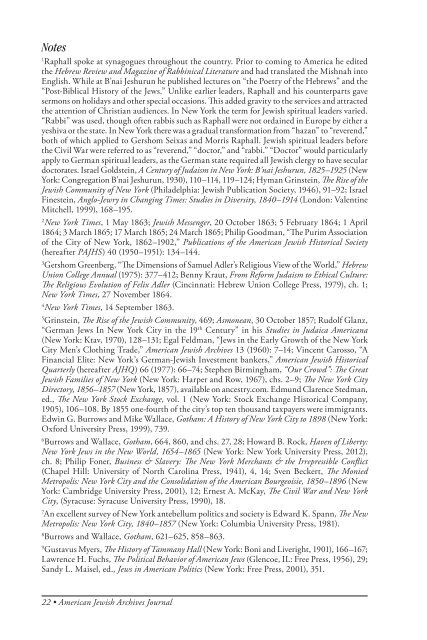American Jewish Archives Journal, Volume 64, Numbers 1 & 2
American Jewish Archives Journal, Volume 64, Numbers 1 & 2
American Jewish Archives Journal, Volume 64, Numbers 1 & 2
You also want an ePaper? Increase the reach of your titles
YUMPU automatically turns print PDFs into web optimized ePapers that Google loves.
Notes<br />
1 Raphall spoke at synagogues throughout the country. Prior to coming to America he edited<br />
the Hebrew Review and Magazine of Rabbinical Literature and had translated the Mishnah into<br />
English. While at B’nai Jeshurun he published lectures on “the Poetry of the Hebrews” and the<br />
“Post-Biblical History of the Jews.” Unlike earlier leaders, Raphall and his counterparts gave<br />
sermons on holidays and other special occasions. This added gravity to the services and attracted<br />
the attention of Christian audiences. In New York the term for <strong>Jewish</strong> spiritual leaders varied.<br />
“Rabbi” was used, though often rabbis such as Raphall were not ordained in Europe by either a<br />
yeshiva or the state. In New York there was a gradual transformation from “hazan” to “reverend,”<br />
both of which applied to Gershom Seixas and Morris Raphall. <strong>Jewish</strong> spiritual leaders before<br />
the Civil War were referred to as “reverend,” “doctor,” and “rabbi.” “Doctor” would particularly<br />
apply to German spiritual leaders, as the German state required all <strong>Jewish</strong> clergy to have secular<br />
doctorates. Israel Goldstein, A Century of Judaism in New York: B’nai Jeshurun, 1825–1925 (New<br />
York: Congregation B’nai Jeshurun, 1930), 110–114, 119–124; Hyman Grinstein, The Rise of the<br />
<strong>Jewish</strong> Community of New York (Philadelphia: <strong>Jewish</strong> Publication Society, 1946), 91–92; Israel<br />
Finestein, Anglo-Jewry in Changing Times: Studies in Diversity, 1840–1914 (London: Valentine<br />
Mitchell, 1999), 168–195.<br />
2 New York Times, 1 May 1863; <strong>Jewish</strong> Messenger, 20 October 1863; 5 February 18<strong>64</strong>; 1 April<br />
18<strong>64</strong>; 3 March 1865; 17 March 1865; 24 March 1865; Philip Goodman, “The Purim Association<br />
of the City of New York, 1862–1902,” Publications of the <strong>American</strong> <strong>Jewish</strong> Historical Society<br />
(hereafter PAJHS) 40 (1950–1951): 134–144.<br />
3 Gershom Greenberg, “The Dimensions of Samuel Adler’s Religious View of the World,” Hebrew<br />
Union College Annual (1975): 377–412; Benny Kraut, From Reform Judaism to Ethical Culture:<br />
The Religious Evolution of Felix Adler (Cincinnati: Hebrew Union College Press, 1979), ch. 1;<br />
New York Times, 27 November 18<strong>64</strong>.<br />
4 New York Times, 14 September 1863.<br />
5 Grinstein, The Rise of the <strong>Jewish</strong> Community, 469; Asmonean, 30 October 1857; Rudolf Glanz,<br />
“German Jews In New York City in the 19 th Century” in his Studies in Judaica <strong>American</strong>a<br />
(New York: Ktav, 1970), 128–131; Egal Feldman, “Jews in the Early Growth of the New York<br />
City Men’s Clothing Trade,” <strong>American</strong> <strong>Jewish</strong> <strong>Archives</strong> 13 (1960): 7–14; Vincent Carosso, “A<br />
Financial Elite: New York’s German-<strong>Jewish</strong> Investment bankers,” <strong>American</strong> <strong>Jewish</strong> Historical<br />
Quarterly (hereafter AJHQ) 66 (1977): 66–74; Stephen Birmingham, “Our Crowd”: The Great<br />
<strong>Jewish</strong> Families of New York (New York: Harper and Row, 1967), chs. 2–9; The New York City<br />
Directory, 1856–1857 (New York, 1857), available on ancestry.com. Edmund Clarence Stedman,<br />
ed., The New York Stock Exchange, vol. 1 (New York: Stock Exchange Historical Company,<br />
1905), 106–108. By 1855 one-fourth of the city’s top ten thousand taxpayers were immigrants.<br />
Edwin G. Burrows and Mike Wallace, Gotham: A History of New York City to 1898 (New York:<br />
Oxford University Press, 1999), 739.<br />
6 Burrows and Wallace, Gotham, 6<strong>64</strong>, 860, and chs. 27, 28; Howard B. Rock, Haven of Liberty:<br />
New York Jews in the New World, 1654–1865 (New York: New York University Press, 2012),<br />
ch. 8; Philip Foner, Business & Slavery: The New York Merchants & the Irrepressible Conflict<br />
(Chapel Hill: University of North Carolina Press, 1941), 4, 14; Sven Beckert, The Monied<br />
Metropolis: New York City and the Consolidation of the <strong>American</strong> Bourgeoisie, 1850–1896 (New<br />
York: Cambridge University Press, 2001), 12; Ernest A. McKay, The Civil War and New York<br />
City, (Syracuse: Syracuse University Press, 1990), 18.<br />
7 An excellent survey of New York antebellum politics and society is Edward K. Spann, The New<br />
Metropolis: New York City, 1840–1857 (New York: Columbia University Press, 1981).<br />
8 Burrows and Wallace, Gotham, 621–625, 858–863.<br />
9 Gustavus Myers, The History of Tammany Hall (New York: Boni and Liveright, 1901), 166–167;<br />
Lawrence H. Fuchs, The Political Behavior of <strong>American</strong> Jews (Glencoe, IL: Free Press, 1956), 29;<br />
Sandy L. Maisel, ed., Jews in <strong>American</strong> Politics (New York: Free Press, 2001), 351.<br />
22 • <strong>American</strong> <strong>Jewish</strong> <strong>Archives</strong> <strong>Journal</strong>
















